Eat More Greens! Eat More Greens!
I often hear people say they love to cook for a party, but the everyday task of feeding themselves is more like a boring chore. Smoothies are an easy choice for breakfast. Grilled cheese requires no thought. It’s so easy to grab something on the way home, or re-heat something out of a box. Even salad gets very same-same after a while. There are creative approaches — did you see Ethan’s Jar Salads? I would eat those every day if he was here to make them for me. But he’s not.
Nevertheless, every day I say to myself, “Eat More Greens”. In an effort to get more invested in what I eat, I planted seeds one year. My kale-growing experiment was an abject failure – the bugs got the crop, and that was that. Spinach needs to be staged in order to harvest it before it bolts — who has time for that? I need an easy way to supplement my “meat and potatoes” routine. A big bowl of salad is — big! Some folks find that satisfying — I just find it takes a long time to consume.
I spend endless evenings watching Food TV, and based on that research, I have come to the conclusion that the easiest way to eat more greens is this: stir fry all that greenage with a little oil, garlic and ginger, finish it with a little salt and pepper and maybe some lemon zest. I can then put in on the plate where the noodles used to be, add a protein – any kind of protein – and call it dinner! It ain’t rocket science, and it’s a great way to get lots of greens into me in a small(er), tasty package.
So all of you singles out there — stop thinking frozen peas are as good for you as a something leafy and colorful. Get in the habit of wilting some greens for dinner. Not as quick as the microwave (which also works, by the way) but ever so much tastier!
You can always microwave your fish.
(eat more fish, eat more fish….)
How to Stir-Fry Greens
First, choose your greens.
Spinach is mild, and so easy to get in pre-washed bales. Kale is still the nutritionists’ darling — chose the baby variety. Bok choy has a lovely mild flavor – chop the big heads crosswise into 1-inch pieces, and cut the babies in halves or quarters. Arugula is quite pungent, but can play nicely with friends. Even lettuce has a place in the pan (Check it out –Google “Stir-Fry Romaine”.) Chard is easy to grow, and the stems are very tasty. Beet greens are delicious too. Visit your specialty Chinese market if you have one, and check out all the different greens there. If you don’t have a guide, just buy a bunch and see if you like it. When I travelled to China, I ate more kinds of greens than I knew existed in the world. Every kitchen I saw, and every bicycle basket headed for home had bunches of fresh greens. China is not known as a salad-eating culture, for the most part, so you know those greens were headed for the wok.
Some greens prefer longer cooking, like curly kale and collards. I think they really are an acquired taste, too. The commercially sold dandelion greens I tried certainly needed blanching to tame their bitterness. Save all these for another time and another cooking method, like soup, maybe.
You can mix things up by using more than one kind of leaf. If you choose all bitter greens, be sure you do it on purpose (arugula is one of those)!
Wash your greens very well in lots of cold water. Dry them very well, in a salad spinner if you have one, or rolled in a tea towel if you don’t. My grandmother used to wash and dry all her produce on the day the groceries came home from the store, so everything was ready to grab and go from that point onward — a very good habit to get into. Wrap your washed and dried greens loosely in a paper towel, and tuck them into a plastic bag. Gramma used to re-use the (washed) bags from the store — see what a good example she set for me?








Check out the quality of the stems of your chosen greens by tasting a little. Remove them if they don’t meet your standards regarding flavor and texture — they’re not going to change much in the stir-frying process. You might be surprised how edible some of those stems are. If they’re too tough or too bitter, send them off to the compost pile.
If it’s just you having dinner, use three big handfuls of whatever leafy goodness you have chosen. If you have guests, put in three handfuls for each of them. My personal limit is 2 baby bok choy, unless they’re really little. This is how I turn my big bowl of salad into something much more compact, and just a little easier to digest (I have an older digestive system. Someday you’ll understand.)
Prepare your flavoring elements.
Garlic and ginger go with practically everything. Grate them with your Microplane or some other grater, chop or slice them finely – whatever floats your boat. Use a little – use a lot – suit yourself. A single clove of garlic, and about a teaspoon of fresh ginger works for me.
I keep grated ginger in little frozen blobs in my freezer, ditto roasted garlic. If you find you’re throwing out a lot of unused (unattended until it sprouts) garlic, get in the habit of peeling and freezing the leftover cloves on the first day you use it. Just pop them in a freezer bag or container, and freeze them. They won’t be as crispy as they were when they were fresh, but the flavor will still be there, and you haven’t wasted anything. You don’t even have to peel the cloves, but they are more “recipe ready” if you do. Ginger can be frozen (wrapped) unpeeled too, but it’s just so easy to grate up everything you bought, and freeze what you don’t use. When I find really nice, fresh, thin-skinned, young-looking ginger, I buy a nice big “hand” and stock up my frozen supply. Garlic powder and ground ginger have their place, but a supply of the fresh frozen stuff in the freezer makes quite a difference to the flavor of stir-fries.
If you wanted to use a pinch of red pepper flakes, you could have that ready. I like it.
A sprinkling of salt and pepper is assumed. Salt will mellow the bitterness in any of the strongly flavored greens.
A little citrus is always welcome. The brightness of an acidic ingredient like lemon juice or a tasty vinegar will brighten the flavor of cooked greens tremendously. Unfortunately, if you add it in the pan, you immediately start to lose the vibrant color you have worked so hard to preserve. Instead, add a wedge of lemon to the plate, or set the vinegar out on the table and add a little just before eating. For good flavor in the pan, a little lemon zest does the job, and doesn’t affect the color at all. Lime or orange zest work too, but be stingy with the lime zest, as it can be quite bitter.
Have everything ready to go (mise en place). The cooking goes very quickly, and you don’t want to be hunting for anything once you begin.




Choose your Weapons:
Use a fairly large frying pan, 12 to 14 inches across the top. No lid required. You want to cook the greens just until they wilt – NOT until they are swimming in their own liquids. You can refer to Cook’s Illustrated to see why a flat-bottomed frying pan works better on North American cooktops than any kind of wok does. When it comes to equipment, I love a good multi-tasker, and a 14-inch skillet can do more things than a wok can (especially if it has a lid).


Have tongs standing by. There is no better piece of equipment to handle this project, unless you are really skilled with kitchen chopsticks (which are about twice as long as eating chopsticks). A high-heat-safe silicon spatula is my second choice; it can handle a small batch.
Choose a vegetable oil:
Canola, sunflower, safflower, rice bran, peanut, corn oil, olive oil that isn’t “extra virgin” – doesn’t matter. Use something with a neutral flavor except…
When I’m cooking spinach, I like to use half rice bran oil, half butter, ‘cause I like the flavor. The oil will keep the butter from burning.

Note to Cook: Plan Ahead. Greens are the last thing you should cook before eating. Your plate should be warm. Your meat or quiche or whatever protein you choose should be cooked and resting under a foil tent. The table should be set.
Now that everything is ready, here we go.
Heat your pan over medium-high for about a minute if you have gas burners, and maybe 2 minutes if you are working with electric burners.
Add a generous teaspoon of oil per serving of greens, and swirl it over the bottom of the pan if you can. Let it get hot to the point where it is very runny, possibly shimmering, and possibly showing very faint wisps of smoke. Don’t walk away — stuff can catch fire.


Add the ginger and garlic and stir them around briskly with the closed ends of your tongs. Add in your pepper flakes here if you are using them. In about 20 seconds the aromatics will be fragrant, and it’s time to move along.


Add the greens, and keep them moving, using your tongs. When they’re wilted and hot, they’re done – it only takes seconds.
Turn off the heat. Sprinkle your greens with salt and pepper now, and add that bit of citrus zest. Turn the greens over one more time to distribute the seasonings.
I hope your plate’s ready 🙂


In a garnishing mood? Sprinkle on nuts, seeds, sliced green onions, a little grated carrot – there are no rules. Suit yourself! Don’t forget that squeeze of lemon or drizzle of vinegar. A few drops of sesame oil will add a wonderful flavor accent.
Another time you could leave out the ginger, and finish your greens with a few drops of balsamic vinegar and a sprinkling of parmesan cheese for a whole different flavor profile.

Pssssst …….. Want a sneaky cheat? Use a couple of squirts of your favorite flavor of oil and vinegar-type dressing in place of all the above, and stir-fry your greens in that. Hot salad! This is chard with Asian Sesame Vinaigrette and oranges. Yum!
Stick to medium temperature – the sugar in commercial dressing will burn quickly.







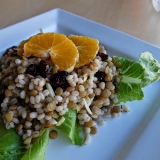
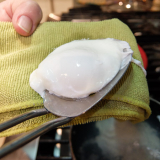
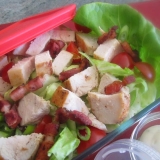



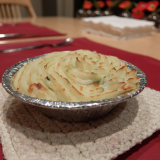


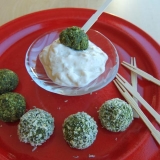



Leave A Comment